Biology 1404 exam review Study guides, Class notes & Summaries
Looking for the best study guides, study notes and summaries about Biology 1404 exam review? On this page you'll find 33 study documents about Biology 1404 exam review.
All 33 results
Sort by
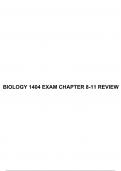
-
BIOLOGY 1404 EXAM CHAPTER 8-11 REVIEW.
- Exam (elaborations) • 3 pages • 2023
- Available in package deal
-
- $10.99
- + learn more
BIOLOGY 1404 EXAM CHAPTER 8-11 REVIEW. CH8 - Photosynthesis CH9 - Cell communication CH10 - Cell reproduction CH11 - Meiosis and sexual reproduction CH8: PHOTOSYNTHESIS 8.1 Photosynthesis is a biological process that captures sunlight and converts it to chemical compound (carbohydrates which are stored in C-C compounds) Carbohydrates - used by organisms to power metabolism (ex. cellular respiration) Only plants, algae and cyanobacteria perform photosynthesis - called photoautotroph...
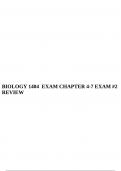
-
BIOLOGY 1404 EXAM CHAPTER 4-7 REVIEW.
- Exam (elaborations) • 3 pages • 2023
- Available in package deal
-
- $10.99
- + learn more
BIOLOGY 1404 EXAM CHAPTER 4-7 REVIEW. CH4 - Cell structure CH5 - Structure and function of plasma membranes CH6 - Metabolism CH7 - Cellular respiration CH4: Cell structure 4.1 A cell is the smallest unit of living things Levels of organization (simplest to complex): cells, tissues, organ, organ system, organism Cells are split into 2 categories: prokaryotic and eukaryotic Bacteria and archaea are PROKARYOTIC Both animal and plant cells are EUKARYOTIC All cells have 1) Cell me...
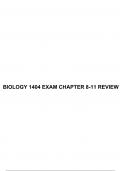
-
BIOLOGY 1404 EXAM CHAPTER 8-11 REVIEW.
- Exam (elaborations) • 3 pages • 2023
- Available in package deal
-
- $10.99
- + learn more
BIOLOGY 1404 EXAM CHAPTER 8-11 REVIEW. CH8 - Photosynthesis CH9 - Cell communication CH10 - Cell reproduction CH11 - Meiosis and sexual reproduction CH8: PHOTOSYNTHESIS 8.1 Photosynthesis is a biological process that captures sunlight and converts it to chemical compound (carbohydrates which are stored in C-C compounds) Carbohydrates - used by organisms to power metabolism (ex. cellular respiration) Only plants, algae and cyanobacteria perform photosynthesis - called photoautotroph...
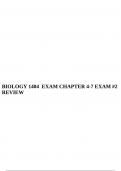
-
BIOLOGY 1404 EXAM CHAPTER 4-7 EXAM #2 REVIEW.
- Exam (elaborations) • 3 pages • 2023
- Available in package deal
-
- $10.99
- + learn more
BIOLOGY 1404 EXAM CHAPTER 4-7 EXAM #2 REVIEW. CH4 - Cell structure CH5 - Structure and function of plasma membranes CH6 - Metabolism CH7 - Cellular respiration CH4: Cell structure 4.1 A cell is the smallest unit of living things Levels of organization (simplest to complex): cells, tissues, organ, organ system, organism Cells are split into 2 categories: prokaryotic and eukaryotic Bacteria and archaea are PROKARYOTIC Both animal and plant cells are EUKARYOTIC All cells have 1) ...
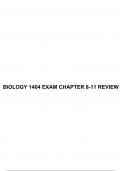
-
BIOLOGY 1404 EXAM CHAPTER 8-11 REVIEW.
- Exam (elaborations) • 3 pages • 2023
- Available in package deal
-
- $10.99
- + learn more
BIOLOGY 1404 EXAM CHAPTER 8-11 REVIEW. CH8 - Photosynthesis CH9 - Cell communication CH10 - Cell reproduction CH11 - Meiosis and sexual reproduction CH8: PHOTOSYNTHESIS 8.1 Photosynthesis is a biological process that captures sunlight and converts it to chemical compound (carbohydrates which are stored in C-C compounds) Carbohydrates - used by organisms to power metabolism (ex. cellular respiration) Only plants, algae and cyanobacteria perform photosynthesis - called photoautotroph...
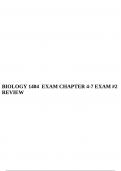
-
BIOLOGY 1404 EXAM CHAPTER 4-7 REVIEW.
- Exam (elaborations) • 3 pages • 2023
- Available in package deal
-
- $10.99
- + learn more
BIOLOGY 1404 EXAM CHAPTER 4-7 REVIEW. CH4 - Cell structure CH5 - Structure and function of plasma membranes CH6 - Metabolism CH7 - Cellular respiration CH4: Cell structure 4.1 A cell is the smallest unit of living things Levels of organization (simplest to complex): cells, tissues, organ, organ system, organism Cells are split into 2 categories: prokaryotic and eukaryotic Bacteria and archaea are PROKARYOTIC Both animal and plant cells are EUKARYOTIC All cells have 1) Cell m...
BIOLOGY 1404 EXAM CHAPTER 8-11 REVIEW & BIOLOGY 1404 EXAM CHAPTER 4-7 EXAM #2 REVIEW.
![Biology 1404 Exam Chapter 4-7 Review [211581]2023](/docpics/6423f481290ed_2528512.jpg)
-
Biology 1404 Exam Chapter 4-7 Review [211581]2023
- Exam (elaborations) • 24 pages • 2023
- Available in package deal
-
- $10.49
- + learn more
If xenon has an atomic number of 54 and a mass number of 108, how many neutrons does it have? - -54 -Atoms that vary in the number of neutrons found in their nuclei are called - -isotopes -Potassium has an atomic number of 19. What is its electron configuration - -shells 1, 2 and 3 are full and shell 4 has one electron -Which type of bond represents a weak chemical bond - -hydrogen bond -Which of the following statements is not true - -Water is the most abundant molecule in the Earth...

-
Biology 1404 Exam Chapter 15-17,21 Review Questions and Answers 2023
- Exam (elaborations) • 3 pages • 2023
- Available in package deal
-
- $8.79
- + learn more
Define Evolution - -the process by which modern organisms have descended from ancient ones -What is a theory - -a well tested explanation of a natural phenomena -How are theories developed? - -theories are developed by frequent testings of hypotheses -Who established the Theory of Evolution by Natural Selection? - -Charles Darwin -What was the name of the book he published? - -The Origin of Species -What island is famous for its relationship to the theory? - -the Galapagos Islands...
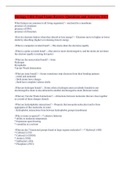
-
Biology 1404 Final Exam Review Questions and Answers 2023
- Exam (elaborations) • 7 pages • 2023
-
- $8.49
- + learn more
What features are common to all living organisms? - -enclosed by a membrane presence of cytoplasm presence of DNA presence of ribosomes -How do electrons behave when they absorb or lose energy? - -Electrons move to higher or lower shells by absorbing (higher) or releasing (lower) energy -What is a nonpolar covalent bond? - -The atoms share the electrons equally -What is a polar covalent bond? - -One atom is more electronegative, and the atoms do not share the electron equally (crea...

How much did you already spend on Stuvia? Imagine there are plenty more of you out there paying for study notes, but this time YOU are the seller. Ka-ching! Discover all about earning on Stuvia


